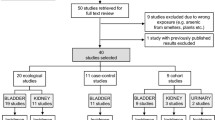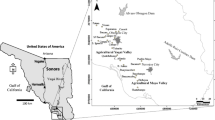Abstract
Agricultural compounds have been detected in drinking water, some of which are teratogens in animal models. The most commonly detected agricultural compounds in drinking water include nitrate, atrazine, and desethylatrazine. Arsenic can also be an agricultural contaminant, although arsenic often originates from geologic sources. Nitrate has been the most studied agricultural compound in relation to prenatal exposure and birth defects. In several case-control studies published since 2000, women giving birth to babies with neural tube defects, oral clefts, and limb deficiencies were more likely than control mothers to be exposed to higher concentrations of drinking water nitrate during pregnancy. Higher concentrations of atrazine in drinking water have been associated with abdominal defects, gastroschisis, and other defects. Elevated arsenic in drinking water has also been associated with birth defects. Since these compounds often occur as mixtures, it is suggested that future research focus on the impact of mixtures, such as nitrate and atrazine, on birth defects.
Similar content being viewed by others
References
Papers of particular interest, published recently, have been highlighted as: • Of importance
Badach H, Nazimek T, Kaminska IA. Pesticide content in drinking water samples collected from orchard areas in central Poland. Ann Agric Environ Med. 2007;14:109–14.
Nolan BT, Hitt KJ. Vulnerability of shallow groundwater and drinking-water wells to nitrate in the United States. Environ Sci Technol. 2006;40:7834–40.
Jaipieam S, Visuthismajarn P, Sutheravut P, et al. Organophosphate pesticide residues in drinking water from artesian wells and health risk assessment of agricultural communities, Thailand. Hum Ecol Risk Assess. 2009;15:1304–16.
Toccalino PL, Norman JE, Scott JC. Chemical mixtures in untreated water from public-supply wells in the U.S.—occurrence, composition, and potential toxicity. Sci Total Environ. 2012;431:262–70.
Joshi N, Rhoades MG, Bennett GD, et al. Developmental abnormalities in chicken embryos exposed to N-nitrosoatrazine. J Toxicol Environ Health A. 2013;76:1015–22.
Hill DS, Wlodarczyk BJ, Finnell RH. Reproductive consequences of oral arsenate exposure during pregnancy in a mouse model. Birth Defects Res B Dev Reprod Toxicol. 2008;83:40–7.
World Health Organization. Maternal, newborn, child, and adolescent health. Child mortality. Available: http://www.who.int/maternal_child_adolescent/topics/child/mortality/en/. Accessed: 10/8/2015.
Heron M. Deaths: leading causes for 2011. Natl Vital Stat Rep. 2015;64:1–96.
Brent RL. Environmental causes of human congenital malformations: the pediatrician’s role in dealing with these complex clinical problems caused by a multiplicity of environmental and genetic factors. Pediatrics. 2004;113(4 Suppl):957–68.
USDA. Agricultural Chemical Use Program. United States Department of Agriculture. National Agricultural Statistics Service. July 2015. Available: http://www.nass.usda.gov/Surveys/Guide_to_NASS_Surveys/Chemical_Use/. Accessed: 10/5/2015.
Carpenter SR, Caraco NF, Correll DL, et al. Nonpoint pollution of surface waters with phosphorous and nitrogen. Ecol Appl. 1998;8:559–68.
Focazio MJ, Reilly TE, Rupert MG, et al. Assessing Ground-Water Vulnerability to Contamination: Providing Scientifically Defensible Information for Decision Makers. U.S. Geological Survey Circular 1224. 2013 Available: http://pubs.usgs.gov/circ/2002/circ1224/. Accessed: 10/5/2015.
U.S. EPA. Basic Information about Nitrate in Drinking Water. U.S. Environmental Protection Agency. February 2014. Available: http://water.epa.gov/drink/contaminants/basicinformation/nitrate.cfm. Accessed: 10/6/2015.
Spahr NE, Dubrovsky NM, Gronberg JM, et al. Nitrate loads and concentrations in surface-water base flow and shallow groundwater for selected basins in the United States, Water Years 1990–2006. National Water Quality Assessment Program. Scientific Investigations Report 2010–5908. U.S. Geological Survey, U.S. Department of the Interior, 2010.
Harvest Public Media. Scientists detect high levels on nitrogen in Midwest waterways. Available: http://harvestpublicmedia.org/article/scientists-detect-high-levels-nitrogen-midwest-waterways. Accessed: 10/5/2015.
Minnesota Pollution Control Agency. Nitrogen in Minnesota Surface Waters: Conditions, Trends, Sources, and Reduction. June 2013. Document Number: wq-s6-26a. St. Paul, MN 55155. Available: http://www.pca.state.mn.us/index.php/view-document.html?gid=19622. Accessed: 10/6/2015.
USDA. USDA Releases 2014 chemical use data for corn and fall potatoes. News release national agricultural statistics service. May 14, 2015. United States Department of Agriculture. Washington, DC 20250.
USDA Economic Research Service. Fertilizer use and price. U.S. Department of Agriculture. May 2011. Available: http://www.ers.usda.gov/data-products/fertilizer-use-and-price. Accessed: 12/21/2015.
Sawyer JE. Nitrogen use in Iowa corn production. CROP 3073. May 2015. Iowa State University Extension and Outreach. Ames, IA 50011.
U.S. Environmental Protection Agency. SDWISFED Drinking Water Data, U.S. Environmental Protection Agency, November 2014. Available: http://water.epa.gov/scitech/datait/databases/drink/sdwisfed/pivottables.cfm. Accessed: 10/20/2015.
CHEEC. Iowa statewide rural well water survey phase 2 (SWRL2): results and analysis. August 2009. Center for Health Effects of Environmental Contamination, The University of Iowa. Iowa City, IA 52242.
Weyer PJ, Brender JD, Romitti PA, et al. Assessing bottled water nitrate concentrations to evaluate total drinking water nitrate exposure and risk of birth defects. J Water Health. 2014;12:755–62.
USGS. Pesticide National Synthesis Project. National water-quality assessment (NAWQA) Program. March 18, 2015.United States Geological Survey, U.S. Department of the Interior. Available: http://water.usgs.gov/nawqa/pnsp. Accessed: 10/5/2015.
ATSDR. Toxicological Profile for Atrazine. Agency for toxic substances and disease registry, CDC. January 2015. Available: http://www.atsdr.cdc.gov/toxprofiles/tp.asp?id=338&tid=59. Accessed: 12/21/2015.
U.S. EPA. Finalization of guidance on incorporation of water treatment effects on pesticide removal and transformations in drinking water exposure assessments. U.S. Environmental Protection Agency. December 2011. Available: http://www.epa.gov/pesticide-science-and-assessing-pesticide-risks/finalization-guidance-incorporation-water-treatment#_2_3_c. Accessed: 12/22/2015.
USGS. Pesticides. Available: http://pubs.usgs.gov/circ/circ1225/pdf/pest.pdf. Accessed: 10/5/2015.
U.S. EPA. Table of regulated drinking water contaminants. U.S. Environmental protection agency. Available: http://www.epa.gov/your-drinking-water/table-regulated-drinking-water-contaminants. Accessed: 12/23/2015.
Henke KR. Arsenic: environmental chemistry, health threats, and waste treatment. West Sussex: Wiley & Sons Ltd; 2009.
Scragg RK, Dorsch MM, McMichael AJ, et al. Birth defects and household water supply. Epidemiological studies in the Mount Gambier region of South Australia. Med J Aust. 1982;2:577–9.
Dorsch MM, Scragg RK, McMichael AJ, et al. Congenital malformations and maternal drinking water supply in rural South Australia: a case-control study. Am J Epidemiol. 1984;119:473–86.
Arbuckle TE, Sherman GJ, Corey PN, et al. Water nitrates and CNS defects: a population-based case-control study. Arch Environ Health. 1988;43:162–7.
Aschengrau A, Zierler S, Cohen A. Quality of community drinking water and the occurrence of late adverse pregnancy outcomes. Arch Environ Health. 1993;48:105–13.
Zierler S, Theodore M, Cohen A, et al. Chemical quality of maternal drinking water and congenital heart disease. Int J Epidemiol. 1988;17:589–94.
Croen LA, Todoroff K, Shaw GM. Maternal exposure to nitrate from drinking water and diet and risk for neural tube defects. Am J Epidemiol. 2001;153:325–31.
Brender JD, Olive JM, Felkner M, et al. Dietary nitrites and nitrates, nitrosatable drugs, and neural tube defects. Epidemiology. 2004;15:330–6.
Holtby CE, Guernsey JR, Allen AC, et al. A population-based case-control study of drinking water nitrate and congenital anomalies using Geographic Information Systems (GIS) to develop individual-level exposure estimates. Int J Environ Res Public Health. 2014;11:1803–23. This recently published paper examines the impact of time trends, specifically the periods of pre- and post-fortification of foods with folic acid, on the relation between drinking water nitrate and congenital anomalies.
Brender JD, Weyer PJ, Romitti PA, et al. Prenatal nitrate intake from drinking water and selected birth defects in offspring of participants in the National Birth Defects Prevention Study. Environ Health Perspect. 2013;121:1083–9. This study used the most comprehensive assessment published to date of maternal exposure to drinking water nitrate that included tap water ingestion from public water supplies and private wells and bottled water.
Cedergren MI, Selbing AJ, Lofman O, et al. Chlorination byproducts and nitrate in drinking water and risk for congenital cardiac malformations. Environ Res. 2002;89:124–30.
Waller SA, Paul K, Peterson SE, et al. Agricultural-related chemical exposures, season of conception, and risk of gastroschisis in Washington State. Am J Obstet Gynecol. 2010;202:241. e1-6.
Mattix KD, Winchester PD, Sherer LR. Incidence of abdominal wall defects is related to surface water atrazine and nitrate levels. J Pediatr Surg. 2007;42:947–9.
Morgenstern H. Ecologic studies in epidemiology: concepts, principles, and methods. Annu Rev Public Health. 1995;16:61–81.
Winchester PD, Huskins J, Ying J. Agrichemicals in surface water and birth defects in the United States. Acta Paediatr. 2009;98:664–9.
Garelick H, Jones H, Dybowska A, et al. Arsenic pollution sources. Rev Environ Contam Toxicol. 2008;197:17–60.
Kwok RK, Kaufmann RB, Jakariya M. Arsenic in drinking-water and reproductive outcomes: a study of participants in the Bangladesh Integrated Nutrition Programme. J Health Popul Nutr. 2006;24:190–205.
Mazumdar M, Valeri L, Rodrigues EG, et al. Polymorphisms in maternal folate pathway genes interact with arsenic in drinking water to influence risk of myelomeningocele. Birth Defects Res A Clin Mol Teratol. 2015;103:754–62. This paper is one of the first to report the results of the impact of genetic characteristics on the relation between a drinking water contaminant and birth defects.
Brender JD, Suarez L, Felkner M, et al. Maternal exposure to arsenic, cadmium, lead, and mercury and neural tube defects in offspring. Environ Res. 2006;101:132–9.
Rudnai T, Sandor J, Kadar M, et al. Arsenic in drinking water and congenital heart anomalies in Hungary. Int J Hyg Environ Health. 2014;217:813–8.
Sanders AP, Desrosiers TA, Warren JL, et al. Association between arsenic, cadmium, manganese, and lead levels in private wells and birth defects prevalence in North Carolina: a semi-ecologic study. BMC Public Health. 2014;14:955.
Jablonowski ND, Schaffer A, Burauel P. Still present after all these years: persistence plus potential toxicity raise questions about the use of atrazine. Environ Sci Pollut Res Int. 2011;18:328–31.
Bochert G, Platzek T, Blankenburg G, et al. Embryotoxicity induced by alkylating agents: left-sided preponderance of paw malformations induced by acetoxymethyl-methylnitrosamine in mice. Arch Toxicol. 1985;56:139–50.
Platzek T, Bochert G, Rahm U. Embryotoxicity induced by alkylating agents. Teratogenicity of acetoxymethyl-methylnitrosamine: dose-response relationship, application route dependency and phase specificity. Arch Toxicol. 1983;52:45–69.
Mallela MK, Werre SR, Hrubec TC. Neural tube defects in mice exposed to tap water. Environ Toxicol. 2011;26:633–40.
Author information
Authors and Affiliations
Corresponding author
Ethics declarations
Conflict of Interest
Jean Brender and Peter Weyer declare that they have no conflict of interest.
Human and Animal Rights and Informed Consent
This article is a review of the literature and therefore does not contain any studies with human or animal subjects.
Additional information
This article is part of the Topical Collection on Water and Health
Rights and permissions
About this article
Cite this article
Brender, J.D., Weyer, P.J. Agricultural Compounds in Water and Birth Defects. Curr Envir Health Rpt 3, 144–152 (2016). https://doi.org/10.1007/s40572-016-0085-0
Published:
Issue Date:
DOI: https://doi.org/10.1007/s40572-016-0085-0




